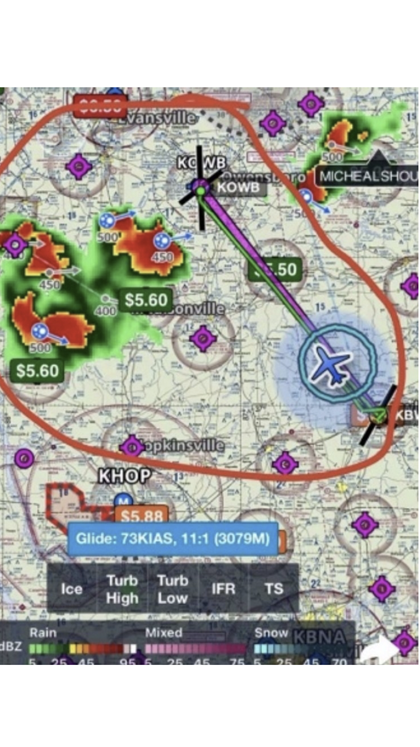Thunderstorms and Snapchat
An unenviable legacy of carelessness, bravado, and cruelty

The flight is off to a poor start. The 22-year-old CFI for this evening’s lesson is irritated at how long the preflight is taking before their approximately three-hour round trip, an irritation he shares in real time on social media along with derogatory remarks about the student. This is not the 19-year-old student’s regular instructor, rather one filling in, and this CFI and student have never flown together before. The CFI notes on Snapchat that they would not get along if this was his full-time student, and laments that he doesn’t have time for a slow student—he has to be awake at 4:30 a.m. the next morning.
The first leg of the flight seemingly goes according to plan, but the instructor and student do not connect. Throughout it, the CFI continues to share a cruel, bully-like distaste of the student on social media. In one post, the CFI indicates that the student welcomes any feedback the CFI has, to which the CFI responds that he does need a lot of help and compares him to “Forrest Gump.” They land in Bowling Green without incident, but when it comes time to return from BWG, significant thunderstorms are growing near their home and destination airport of OWB. With some tops at 50,000 feet with hail, the towering, concentrated cells are projected to move directly toward their planned route of flight.
 But this does not deter the flight instructor. The storms extend both east and west with a small gap at their home airport. Instead of grounding the flight and planning to try again in the morning, the airplane departs BWG around 9:55 p.m. before climbing to 4,500 feet msl and proceeding on a course direct to OWB. About 20 minutes later, the CFI takes a screenshot of ForeFlight radar on his smartphone and shares that screenshot on social media after they’ve taken off. It shows their direct track between the two airports, and that track is headed toward the storm. The CFI circles his route and the radar in red. He is aware of what he and his student are flying toward.
But this does not deter the flight instructor. The storms extend both east and west with a small gap at their home airport. Instead of grounding the flight and planning to try again in the morning, the airplane departs BWG around 9:55 p.m. before climbing to 4,500 feet msl and proceeding on a course direct to OWB. About 20 minutes later, the CFI takes a screenshot of ForeFlight radar on his smartphone and shares that screenshot on social media after they’ve taken off. It shows their direct track between the two airports, and that track is headed toward the storm. The CFI circles his route and the radar in red. He is aware of what he and his student are flying toward.
What the CFI’s plan is is impossible to say. Maybe he thinks they will beat the storm. Maybe he underestimates the terrible strength of convection, where updrafts and downdrafts can exceed 6,000 feet per minute with severe turbulence, icing, hail, and, of course, lightning. Perhaps this young CFI’s decision-making is the result of a flight instructor who, during his own training, did not properly teach him about thunderstorms. Perhaps he had threaded the needle between thunderstorm cells with success in the past, and assumed this flight would be equally successful. No matter the reason, the storms do not deter the CFI and he continues the flight.
At around 10:44 p.m. local time, the CFI contacts ATC. The controller advises the pilot of heavy to extreme precipitation at their 9 o’clock. About two minutes later, the CFI requests an IFR clearance, indicating that they are very close to the storm system. The controller issues the clearance, along with a vector to the east, away from the weather. The CFI says that they are “getting blown around like crazy,” and the flight track shows a turn to the northwest followed by a right circling turn. The controller gives the easterly vector for a second time, and the flight instructor responds that they are in “pretty extreme turbulence.” No further communications are received.
After the final call, the flight track shows the right descending turn continued. The airplane’s last known position, just five minutes after the CFI called ATC, was at an altitude of 2,200 feet and about 1,000 feet northwest of the 25-acre wreckage debris field. Both the CFI and student died.
Retrospective
The NTSB’s final report will shed more light on the details of this accident, but it is clear that the fatal mistake was an inaccurate risk perception that might have been driven by one or more hazardous attitudes, followed by the accident instructor’s decision to fly into a thunderstorm. As a result, two young lives and dreams were cut short by the decisions of one.
The CFI’s decision to continue might have been influenced by external factors such as logging valuable night PIC hours toward the magical ATP minimum 1,500 hours, earning income, and returning to his home base that night to meet his early morning obligation. Had he not had plans so early the next morning, it may have been easier to make the decision to divert or cancel the return leg of the flight. While it is always tempting to add more hours to the logbook, a one-night delay would have been preferable to the outcome of the flight.
Throughout the flight the CFI exhibited a stunning lack of professionalism. A CFI’s cellphone use should be minimal and only related to the flight—not updating friends on the ground about what a time he’s having with his student, good or bad. While the instructor’s use of his cellphone didn’t cause the accident, it was one more link in the accident chain—and an unnecessary distraction from his highest priority—the safe operation of the airplane. Had he been paying more attention to the flight and his responsibility as a flight instructor, this outcome could have been avoided. This behavior also raises concerns about the safety culture of the flight school that failed to assure instructors were behaving in accordance with established CFI norms.
The accident instructor’s cellphone usage and disrespectful behavior was likely not something that manifested that evening—it was probably part of a pattern, and it is a reminder that not everybody should be a CFI. A CFI has a responsibility of professionalism and safety to their students, characteristics that this CFI evidently lacked. Gaining the experience necessary for career advancement should not come at the expense of students. A CFI should be there to teach, not just check boxes on the way to a more lucrative career. Instructing is a privilege, not a right.
Had he been paying more attention to the flight and his responsibility as a flight instructor, this outcome could have been avoided.It is also critical that CFIs make an effort to earn their students’ trust and respect, both of which are building blocks to effective and open learning. Also, both students and CFIs can help ensure a good fit by meeting or talking on the phone before the flight to get to know each other, and both should have the power to veto a flight if it is a poor fit. The student probably sensed the CFI’s contempt, but he too may have felt pressure to complete the lesson as planned. And maybe he didn’t realize that even at the young age of 19, that he as the customer had the right to call off the flight for the CFI’s attitude alone.
There is a degree of blind trust required in flight training, especially early on. As a student you trust the person to not steer you wrong, and to make hard decisions to keep you both safe. But this CFI took the student into a worst-case scenario, and in the process humiliated the student and himself.
It takes dedication to earn a CFI certificate at any age, and to earn it so young demonstrates a certain commitment to aviation. He didn’t want this flight to end in an accident, but the fact that it did means he left behind an unenviable legacy of carelessness, bravado, and cruelty, and he robbed his trusting student of a future. 



